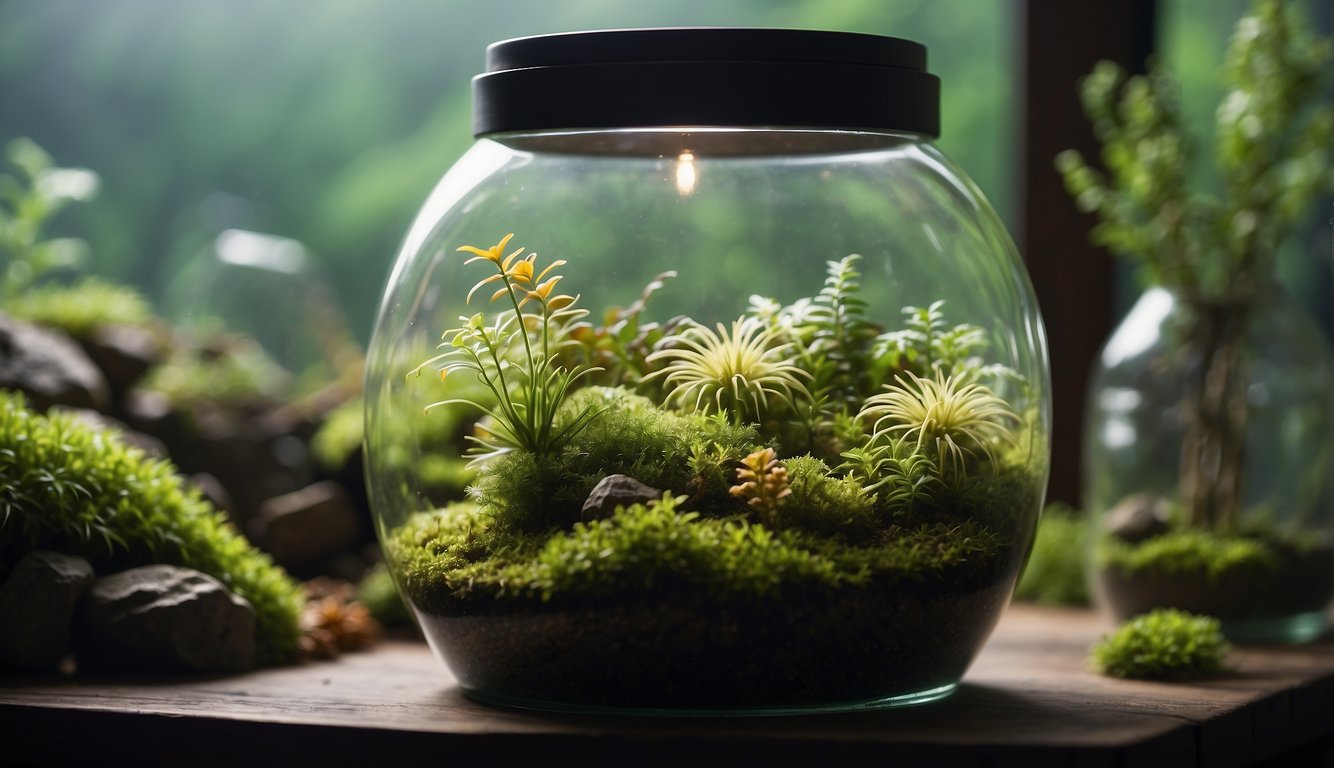TheHerbProf.com is a treasure trove of knowledge for those interested in natural healing and herbal remedies. The website is run by Paul Johnston MD. A naturopathic who has not only received extensive education in the field but also has personal experience in self-healing.
How to grow moss inside? Growing moss inside is a great way to add a touch of green to your home decor. Moss is a versatile plant that can be grown in a variety of containers, from glass terrariums to plastic pots. It is a low-maintenance plant that can thrive in low-light conditions, making it perfect for indoor gardening.
To grow moss indoors, you will need to create a suitable environment for it to thrive. This includes providing the right amount of light, moisture, and nutrients. You can use a variety of materials to create a suitable growing medium, including potting soil, peat moss, and sand. Once you have created the ideal environment for your moss, you can sit back and watch it grow.
Understanding Moss
Moss is a type of bryophyte, a group of non-vascular plants that lack roots, stems, and leaves. Mosses grow in dense mats or clumps, and they can be found in a variety of habitats, including forests, wetlands, and deserts. In this section, I will discuss the different types of moss and the requirements for growing moss indoors.
Types of Moss
There are over 12,000 species of moss, and they can be classified into two main groups: acrocarpous and pleurocarpous. Acrocarpous mosses grow in upright, compact tufts, while pleurocarpous mosses grow in spreading mats. Some common types of moss include:
- Cushion moss (acrocarpous)
- Haircap moss (acrocarpous)
- Sheet moss (pleurocarpous)
- Fern moss (pleurocarpous)
Each type of moss has its own unique characteristics, such as growth rate, texture, and color. Understanding the different types of moss can help you choose the right species for your indoor moss garden.
Moss Growth Requirements
To grow moss indoors, you need to provide the right conditions for growth. Mosses require:
- Light: Mosses prefer low to medium light conditions and can tolerate some shade. Direct sunlight can dry out the moss and cause it to die.
- Moisture: Mosses require a constant source of moisture to grow. They can absorb water through their leaves and stems, and they can also absorb moisture from the air.
- Nutrients: Mosses do not require fertilizer, but they do require nutrients such as nitrogen, phosphorus, and potassium. These nutrients can be found in decaying organic matter, such as leaves and soil.
- Humidity: Mosses prefer high humidity levels, around 70% or higher. You can maintain high humidity levels by using a closed container or a humidifier.
- Temperature: Mosses grow best in cool temperatures between 50-75°F. They can tolerate some fluctuations in temperature, but extreme temperatures can damage or kill the moss.
By understanding the growth requirements for moss, you can create the right environment for your indoor moss garden. Providing the right conditions can help your moss thrive and create a beautiful, natural addition to your home.
Preparing the Indoor Environment
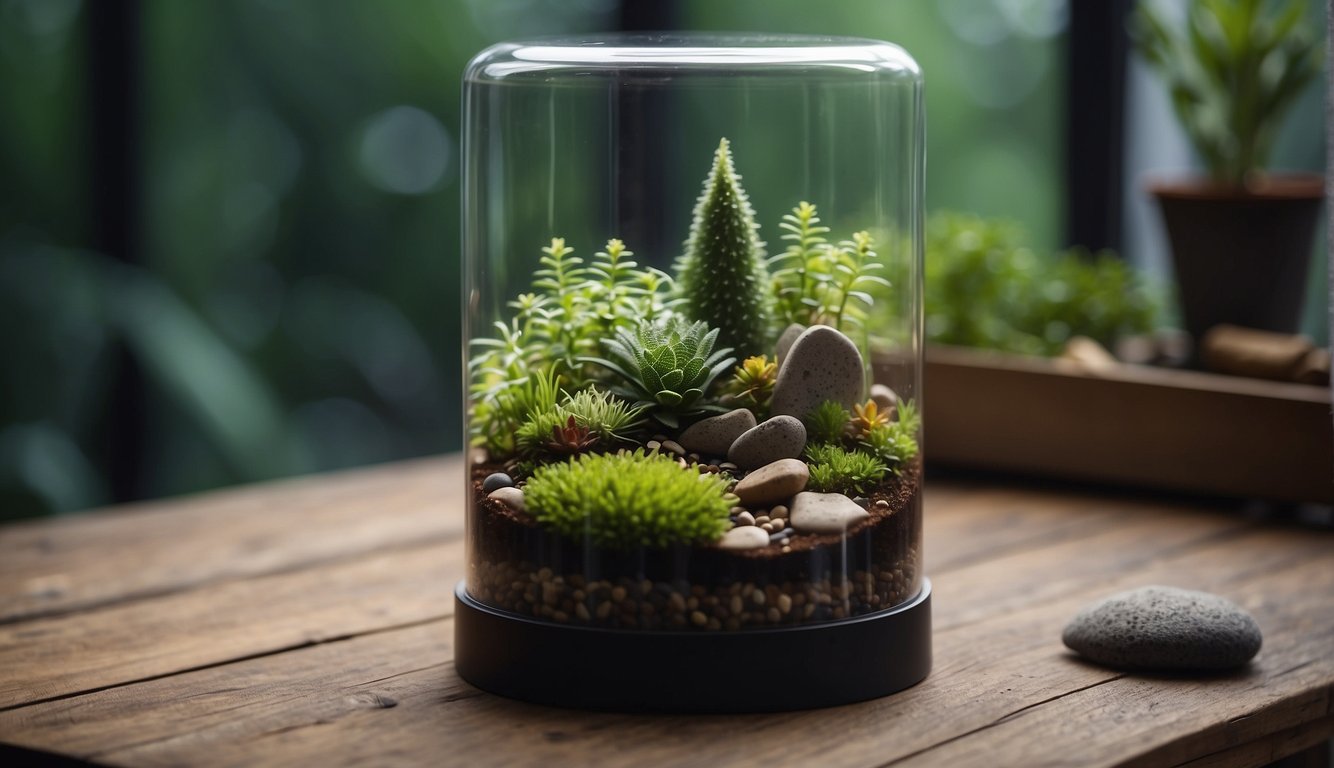
Growing moss indoors requires creating a suitable environment that mimics the conditions of its natural habitat. Here are some essential steps to prepare your indoor environment for your moss garden.
Choosing the Right Location
When setting up an indoor moss garden, it’s essential to choose the right location to ensure the moss thrives. Most moss species prefer indirect or shaded light, making them ideal for areas that receive filtered sunlight or are away from direct windows.
It’s best to avoid placing your moss garden in a spot that receives direct sunlight, as this can scorch the moss. Instead, opt for a location that receives bright, indirect light.
Lighting and Temperature Control
While moss can grow in low light conditions, it’s essential to provide additional lighting to promote healthy growth. You can use a fluorescent lamp or a garden lamp to supplement the natural light in the room.
It’s also essential to maintain a consistent temperature in the room where you grow your moss. Most moss species thrive in temperatures between 60-80°F. Avoid placing your moss garden in areas with extreme temperature fluctuations, such as near air conditioning vents or heaters.
Maintaining Humidity
Moss requires high humidity levels to grow and thrive. You can maintain humidity levels by regularly misting the moss with water or by placing a humidifier in the room.
It’s also essential to choose the right container for your moss garden. Glass or plastic containers work well, but make sure they are wide and shallow so you can easily reach into them to maintain your moss. Additionally, if you opt for a terrarium, be sure it comes with a lid to best store your moss.
By following these simple steps, you can create a suitable environment for your indoor moss garden to thrive.
Selecting and Preparing the Substrate
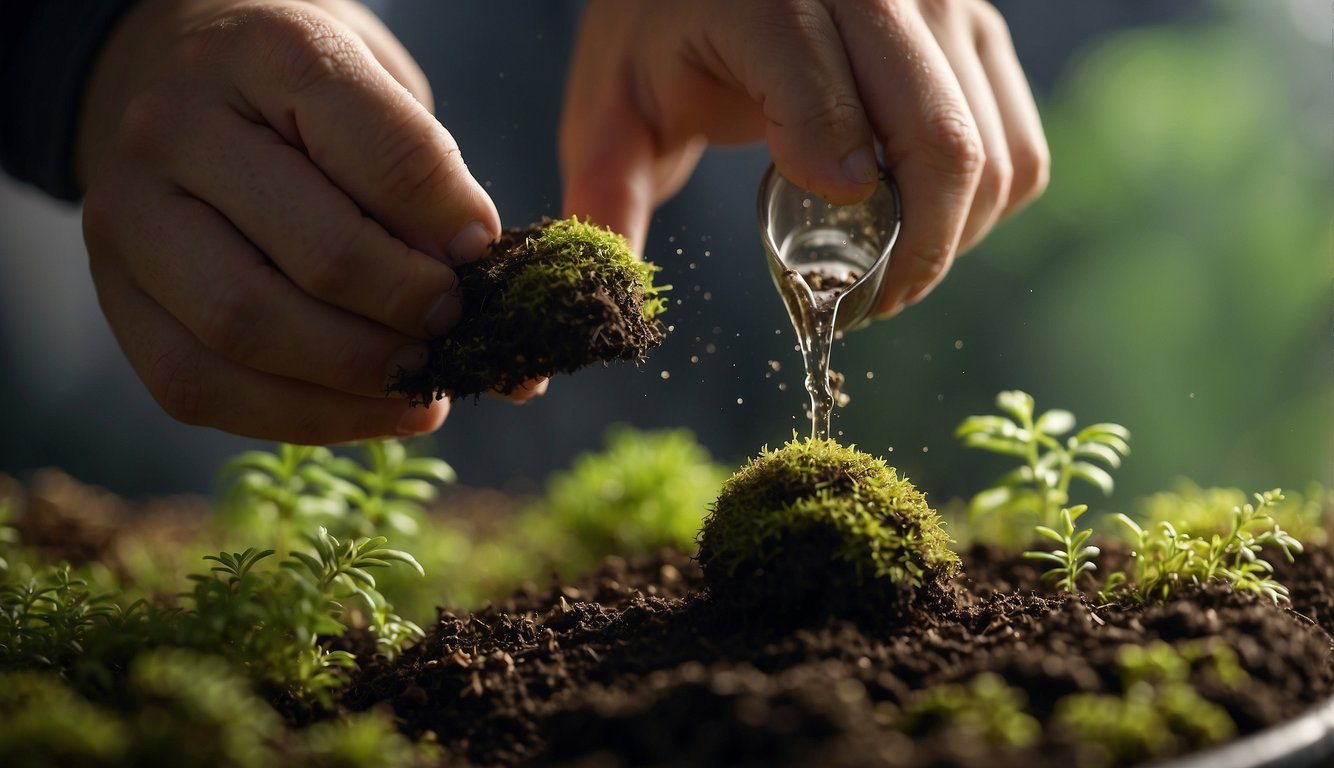
When growing moss indoors, it’s essential to select the right substrate for optimal growth. Moss is a non-vascular plant that doesn’t have true roots, so it absorbs moisture and nutrients through its leaves. Therefore, the substrate should be porous and capable of holding moisture without becoming waterlogged.
Soil Requirements – How to Grow Moss Inside?
Moss prefers acidic soil with a pH range of 5.0 to 6.0. Therefore, it’s essential to use soil that is acidic or neutral. Potting soil can be used as a substrate for moss, but it’s crucial to ensure that it’s free of any fertilizers or chemicals that can harm the plant. A soil test can help determine the pH level and the presence of any harmful substances.
Alternative Substrates
Apart from soil, there are other substrates that can be used for growing moss indoors. Rocks, sand, and pine needles are some of the alternatives that can be used. Rocks and sand provide a stable surface for the moss to grow, while pine needles create a natural acidic environment that is ideal for the plant.
When using rocks or sand, it’s essential to ensure that they are clean and free of any chemicals that can harm the moss. Pine needles should be fresh and free of any debris or insects. It’s also crucial to ensure that the substrate is moist but not waterlogged, as this can lead to the growth of harmful bacteria and fungi.
Selecting the right substrate is crucial for growing moss indoors. Whether using soil or alternative substrates, it’s essential to ensure that they are free of any harmful substances and capable of holding moisture without becoming waterlogged. With the right substrate, moss can thrive indoors and add a touch of natural beauty to any space.
Planting and Cultivation – How to Grow Moss Inside?
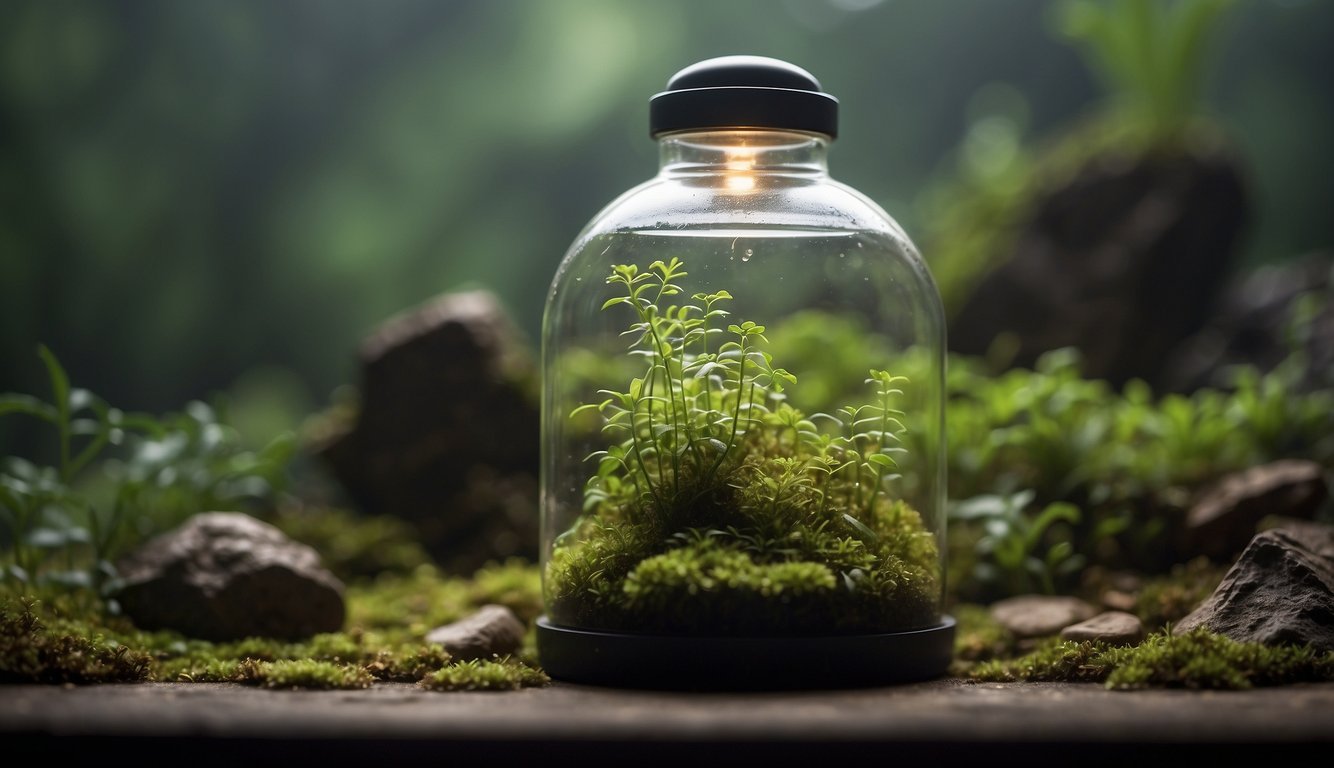
Growing moss indoors can be a rewarding and enjoyable experience. To successfully cultivate moss, you need to follow some basic planting and cultivation techniques. In this section, I will cover the most important aspects of planting and cultivating moss indoors.
Moss Propagation – How to Grow Moss Inside?
Moss can be propagated by spores or by transplanting existing moss. If you want to propagate moss from spores, you need to create a suitable environment for the spores to grow. You can do this by mixing chopped moss with compost and blending it in a blender. This will create a moss slurry that you can spread on a suitable surface. You can also use a spray bottle to mist the surface to keep it moist.
Transplanting Techniques
If you want to transplant moss from an existing moss garden, you need to be careful not to damage the moss. You should use a sharp knife to cut out a section of the moss and transplant it to the new location. The new location should have a similar environment to the original location to ensure the moss thrives.
Creating a Moss Slurry
A moss slurry is a great way to propagate moss indoors. To create a moss slurry, you need to mix chopped moss with compost and blend it in a blender. You can then spread the moss slurry on a suitable surface and mist it with a spray bottle to keep it moist. The moss should start growing within a few weeks.
Growing moss indoors can be a fun and rewarding experience. By following the planting and cultivation techniques outlined in this section, you can create a beautiful and thriving moss garden in your home. Remember to be patient and consistent in your efforts to cultivate moss, and you will be rewarded with a beautiful and lush indoor garden.
Moss Care and Maintenance – How to Grow Moss Inside?
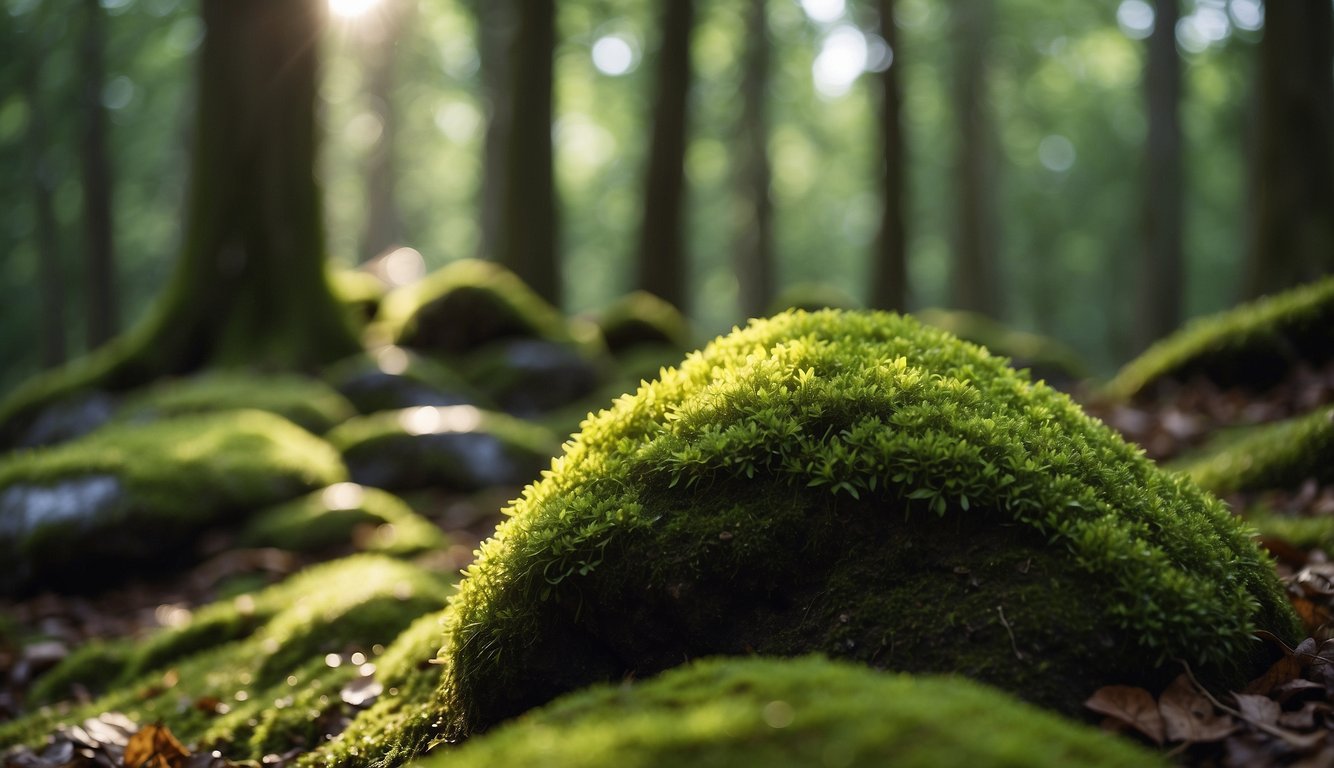
Growing moss indoors requires proper care and maintenance to ensure its longevity and vibrancy. In this section, I will provide some tips on how to care for and maintain your indoor moss.
Watering Practices
Moss requires consistent moisture to thrive, but overwatering can lead to root rot. The best way to water moss is to mist it lightly with a spray bottle once or twice a day. You can also place a tray of water near the moss to increase humidity levels. It is important to monitor the moisture level of your moss regularly to prevent it from drying out or becoming too wet.
Fertilizing Moss
Moss does not require fertilizer, but you can use a diluted liquid fertilizer once a month to promote growth. Be sure to use a fertilizer that is specifically formulated for moss and follow the instructions carefully. Over-fertilizing can damage the moss, so it is important to use the correct amount.
Pruning and Weeding – How to Grow Moss Inside?
Regular pruning and weeding are essential to maintaining healthy moss. Use a small rake or your fingers to remove any dead or brown patches. You can also use a pair of scissors to trim any overgrown areas. Be sure to remove any weeds or other plants that may be growing in the moss, as they can compete for nutrients and water.
Pests
Moss is generally pest-resistant, but it can attract snails, slugs, and other small insects. If you notice any pests, you can remove them manually or use an organic insecticide. Be sure to read the label carefully and follow the instructions to avoid damaging the moss.
Caring for and maintaining your indoor moss requires consistent watering, occasional fertilizing, regular pruning and weeding, and monitoring for pests. By following these simple tips, you can enjoy a lush and vibrant moss garden in your home.
Designing with Moss – How to Grow Moss Inside?
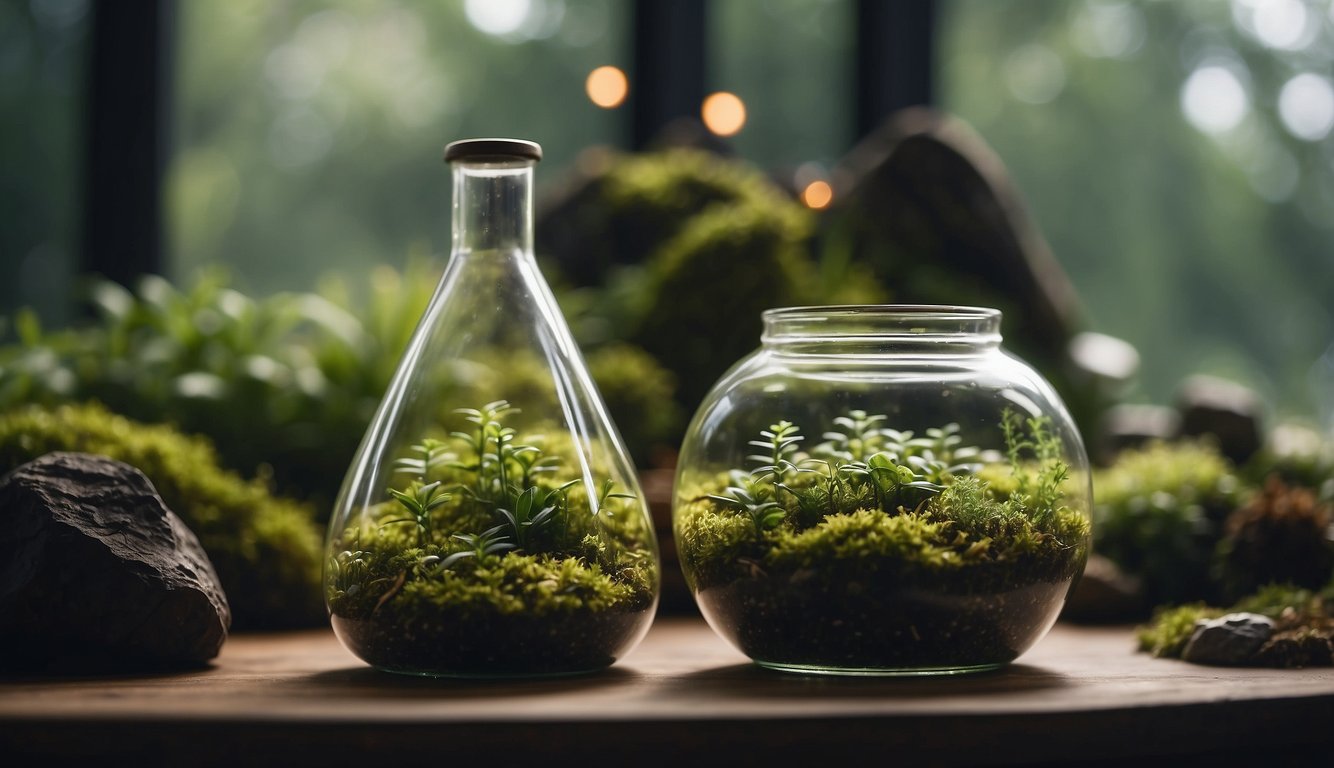
As a versatile plant, moss can be used to create stunning decorative arrangements. Here are two ways you can use moss to enhance your indoor space:
Moss in Terrariums – How to Grow Moss Inside?
Terrariums are a great way to showcase moss and create a miniature ecosystem. When designing a moss terrarium, it’s important to choose a container with a lid to maintain a closed environment. This will help to keep the humidity levels high and create the perfect growing conditions for your moss.
Start by adding a layer of pebbles or rocks to the bottom of your container for drainage. Next, add a layer of potting soil and then place your moss on top. There are many varieties of moss to choose from, including sheet moss and cushion moss. You can mix and match different types of moss to create a unique and visually appealing arrangement.
Once you have arranged your moss, add some decorative elements such as small figurines or rocks to create a miniature landscape. Remember to mist your moss regularly to keep it hydrated and healthy.
Decorative Moss Arrangements
Moss can also be used to create decorative arrangements that can be displayed on shelves or tables. To create a decorative moss arrangement, start by gathering materials such as a shallow container, pebbles, and different varieties of moss.
Arrange the pebbles in the bottom of the container and then add a layer of potting soil. Next, arrange your moss on top of the soil. You can use different types of moss to create a visually interesting arrangement.
To add some extra decoration, you can add small figurines or other decorative elements to your moss arrangement. Remember to mist your moss regularly to keep it hydrated and healthy.
Using moss in your indoor decor is not only visually appealing, but also eco-friendly. Moss is a low-maintenance plant that requires minimal watering and can thrive in a closed container environment. With a little creativity, you can use moss to create stunning and unique decorative arrangements that will enhance your indoor space.
Troubleshooting Common Issues – How to Grow Moss Inside?

Managing Pests and Disease
One of the most common issues when growing moss indoors is the occurrence of pests and diseases. Some of the most common pests that can affect your moss include weeds and bugs. To manage weed growth, it is important to ensure that the moss is grown in an environment that is not conducive to weed growth. This can be achieved by avoiding direct sunlight and using acidic soils.
Bugs can also be a problem when growing moss indoors. If you notice any bugs on your moss, it is important to address the issue immediately. One way to do this is by spraying the moss with a mixture of water and dish soap. This will help to kill the bugs without harming the moss.
Mold is another common problem that can affect moss growth. To prevent mold growth, it is important to ensure that the moss is grown in a well-ventilated area. If mold does occur, it can be addressed by removing the affected area and treating it with a mixture of water and vinegar.
Addressing Moss Growth Problems – How to Grow Moss Inside?
Another common issue when growing moss indoors is moss growth problems. Moss growth problems can occur due to a variety of factors, including drought, lack of nutrients, and erosion control issues.
To address drought-related moss growth problems, it is important to ensure that the moss is watered regularly. Moss is a drought-tolerant plant, but it still requires regular watering to thrive.
If your moss is not growing due to lack of nutrients, you can address the issue by adding fertilizer to the soil. It is important to use a fertilizer that is specifically designed for moss, as other types of fertilizers can harm the plant.
Finally, erosion control issues can also affect moss growth. To address erosion control issues, it is important to ensure that the moss is grown in an area that is not prone to erosion. If erosion does occur, it can be addressed by adding rocks or other materials to the affected area to help stabilize the soil.
By addressing these common issues, you can ensure that your moss grows healthy and strong indoors.
Moss and Eco-Friendly Practices – How to Grow Moss Inside?

Moss is an eco-friendly and sustainable option for indoor gardening. It is a drought-tolerant plant that can thrive in acidic soils and is easy to grow indoors. Not only is it a low-maintenance plant, but it also has several benefits for the environment.
Moss for Erosion Control – How to Grow Moss Inside?
Moss is an excellent option for erosion control. It can grow on rock walls, slopes, and other areas where erosion is a problem. Moss has a shallow root system that helps to stabilize soil and prevent erosion. It also absorbs water and nutrients from the soil, reducing runoff and preventing soil erosion.
Sustainable Gardening with Moss
Moss is a sustainable option for gardening. It does not require any fertilizers or pesticides, making it an eco-friendly choice. Moss also helps to purify the air by absorbing pollutants and releasing oxygen. It is a natural air filter that can improve indoor air quality.
In addition to being sustainable, moss is also a beautiful addition to any backyard or indoor garden. It comes in a variety of colors and textures, making it a versatile option for landscaping. Moss can be used to create a moss garden, a moss terrarium, or as a ground cover for other plants.
Moss is an excellent option for eco-friendly and sustainable gardening. It is easy to grow, low maintenance, and has several benefits for the environment. Whether you are looking for a way to control erosion or create a beautiful indoor garden, moss is a great option to consider.
Legal and Ethical Considerations – How to Grow Moss Inside?
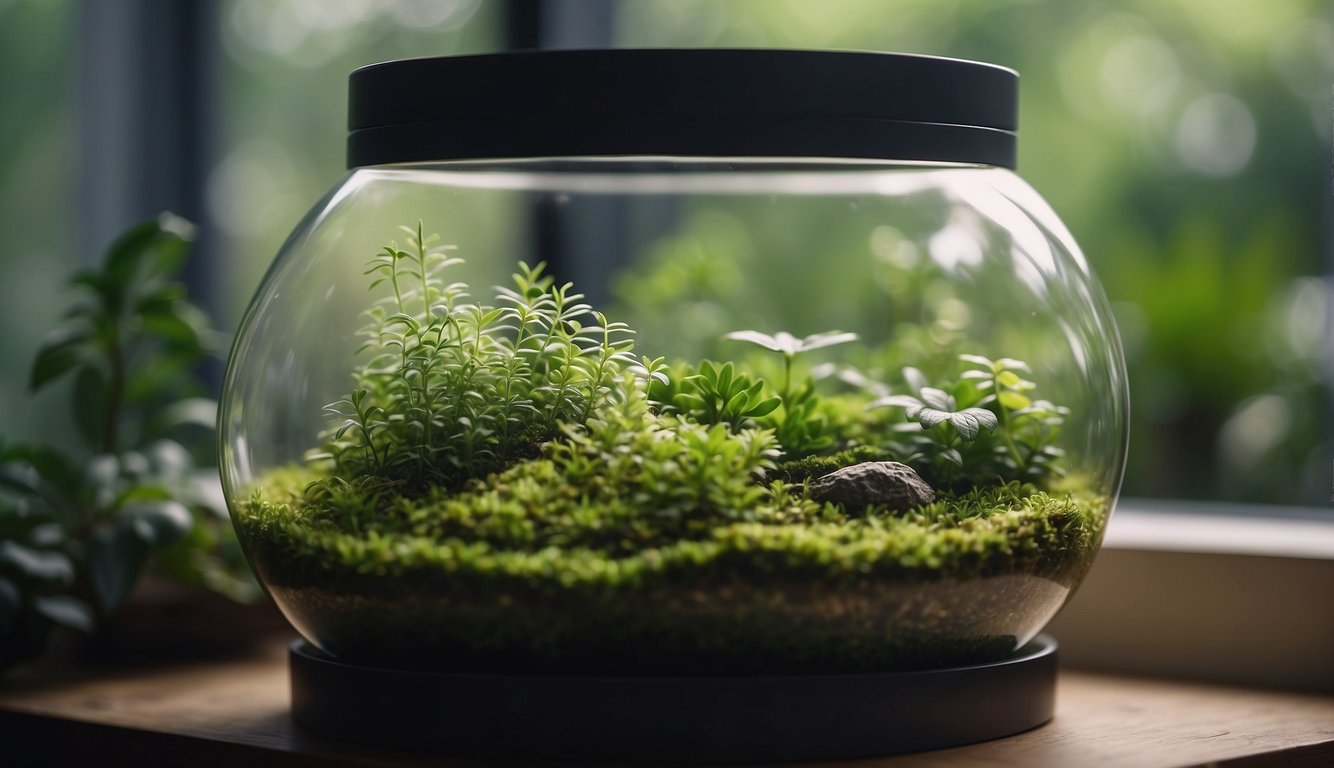
Growing moss inside may seem like a harmless activity, but there are legal and ethical considerations that you should be aware of. In this section, I will discuss some of the most important considerations to keep in mind.
Harvesting Moss Responsibly
Before you start growing moss inside, it’s important to understand that moss is a slow-growing and delicate plant. Therefore, it’s crucial to harvest it responsibly. If you’re planning to harvest moss from the wild, make sure you do so sustainably and legally. In some areas, it may be illegal to harvest moss without a permit, so be sure to check your local laws and regulations.
If you’re not sure where to find moss in your area, consider joining a local moss club or group. These organizations can provide you with information on where to find moss and how to harvest it responsibly. You can also purchase moss from reputable nurseries and garden centers.
Seeking Permission and Compliance – How to Grow Moss Inside?
If you’re planning to harvest moss from public or private property, it’s important to seek permission from the landowner first. This is not only respectful but also ensures that you’re not breaking any laws or regulations. Some landowners may require you to sign a waiver or obtain a permit before harvesting moss, so be sure to ask about their requirements.
In addition to seeking permission, it’s important to comply with any laws or regulations related to moss harvesting and cultivation. For example, in Japan, it is illegal to transplant moss from its natural habitat without a permit. Therefore, if you’re planning to cultivate moss from wild specimens, be sure to check your local laws and regulations to ensure that you’re not breaking any rules.
Growing moss inside can be a rewarding and peaceful activity, but it’s important to do so responsibly and legally. By following the tips and guidelines outlined in this section, you can ensure that you’re harvesting and cultivating moss in a sustainable and ethical manner.
How to Grow Moss Inside
Let’s delve into the fascinating world of indoor moss gardening!
Firstly, you’ll need a shallow container. Moss doesn’t have deep roots, so it doesn’t need a deep pot. It’s all about the surface area!
Next, let’s talk about light. Moss loves indirect light. So, find a spot that gets plenty of daylight, but not direct sun.
Ever heard of misting? Moss loves humidity. A daily misting will keep your moss happy and green!
And let’s not forget patience. Moss grows slowly. But watching it spread and grow is part of the fun!
Remember, folks, gardening is all about patience and love. So, let’s keep planting, keep nurturing, and keep enjoying the greenery in our homes!
For more indoor gardening tips, don’t forget to visit my homepage at theherbprof.com. Keep those green thumbs up!
References – How to Get Rid of Rhubarb?
Little Herb Encyclopedia, by Jack Ritchason; N.D., Woodland Publishing Incorporated, 1995
The Ultimate Healing System, Course Manual, Copyright 1985, Don Lepore
Planetary Herbology, Michael Tierra, C.A., N.D., Lotus Press, 1988
Handbook of Medicinal Herbs, by James A. Duke, Pub. CRP Second Edition 2007
The Complete Medicinal Herbal, by Penelope Ody, Published by Dorling Kindersley
Check the Following Articles!
Organic Rooting Hormone: Boosting Plant Growth Naturally
Can You Eat Thyme Stems? A Comprehensive Guide
How to Get Rid of Rhubarb: A Comprehensive Guide
Frequently Asked Questions – How to Grow Moss Inside?

What are the best types of moss for indoor cultivation?
The best types of moss for indoor cultivation are those that prefer low light and high humidity environments. Some of the most popular varieties include sheet moss, fern moss, and mood moss. These types of moss are easy to grow and maintain indoors, making them perfect for beginners.
What are the benefits of having moss indoors?
There are many benefits to having moss indoors, including improved air quality, reduced stress levels, and a calming effect on the environment. Moss also helps to absorb moisture and pollutants from the air, making it a great natural filter. Additionally, moss is easy to care for and can be used to create beautiful interior decorations.
Can moss be grown indoors without using soil?
Yes, moss can be grown indoors without using soil. In fact, many mosses prefer to grow on surfaces such as rocks, logs, or other organic materials. To grow moss indoors without soil, you can use a moss substrate made from peat moss, sand, and other organic materials.
How can I start growing moss indoors if I don’t already have a moss sample?
If you don’t already have a moss sample, you can purchase moss spores or moss plugs from a garden center or online retailer. Alternatively, you can collect moss from your yard or a nearby park. To collect moss, simply scrape a small section of moss from a rock or tree and transfer it to a container.
What steps are needed to create a moss bowl for interior decoration?
To create a moss bowl for interior decoration, you will need a shallow bowl or container, a moss substrate, and a variety of mosses. Start by filling the container with the moss substrate, then arrange the different types of moss on top. You can also add other decorative elements such as rocks, shells, or small figurines to create a unique display.
How can I successfully maintain a healthy moss garden inside my home?
To maintain a healthy moss garden inside your home, it’s important to keep the environment moist and humid. This can be achieved by misting the moss regularly and placing the container in a location that receives indirect sunlight. It’s also important to avoid overwatering and to provide adequate drainage to prevent the moss from becoming waterlogged.
